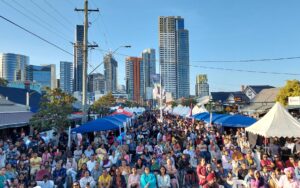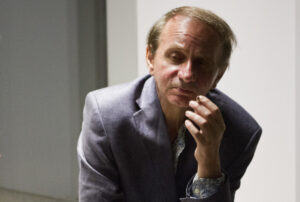Pride Month has been, and thankfully gone. However, during Pride Month, you will have noticed the bright, bold and colourful LGBT material plastered everywhere. But which demographic is most attracted to these colourful displays, and what would curious eyes see if they were to attend a supposedly ‘family friendly’ Pride event?
Last Sunday the wife was engaged in some house work – and if there’s one thing that I don’t want to get dragged into doing on a Sunday it is any form of domestic chore. So, I took the opportunity to offer to help, by taking our daughter, Sophia, out for the afternoon. That way the Mrs could focus all of her womanly powers on the task at hand.
So off we went to a local National Trust site which consists of a large stately home, gardens, interconnected lakes and a children’s play area built into the surrounding woods. This was meant to be a nice afternoon out in the countryside – and for the most part it was.
However, as we walked through a large courtyard to get an ice cream, I noticed that the entire area was decked out with LGBT flags. And these flags were everywhere. Luckily however Sophia didn’t notice them as she was laser focused on the chocolate ice cream cone that she wanted and instead of observing what was going on around her, she spent the time repeatedly asking me why the man at the ice cream stall was going so slowly.
But as we queued for the ice cream, I observed that there were more than just LGBT flags on show, there was also a ‘Pride’ stall that had been erected nearby. It was being run by two women, one looked like a typical elderly liberal and the other, well, she was about the size of a baby elephant and exhibited every visual tale tell sign that the she was firmly in the grip of the liberal mind virus.
I cautiously observed the Pride stall as we queued for the ice cream, making every effort possible not to draw any attention to it. But I immediately noticed that the whole focus of this stall was children. There were rainbow arts and crafts that could be done with scissors – and the hands of the scissors we all different colours, collectively making a rainbow when they were all placed together. There was a small paddling pool with a hook a duck game. There was a rainbow ring toss game. And there were other items on the table that I couldn’t make out, and I certainly wasn’t going to take my daughter closer to inspect. But as I said earlier it was absolutely clear that this was all squarely aimed at children. And when I say children, I am not talking about teens, I am talking about CHILDREN of primary school age.
It was clear that the National Trust was using its sizeable funding to push an adult event based around sexually charged themes upon pre-pubescent minors. And let’s be clear: LGBT is about sexual orientation and sexual preference, and the age of sexual consent in Britain is 16-years-of-age. So why on earth are children under the age of 16 being targeted with games, crafts and other activities aimed at introducing them to a topic that they are not able to properly understand, and even if they did, they would be under the age of consent to participate in? And let’s also be clear about something else, it’s not just the National Trust that is pushing this agenda on children – this is a widespread practice.
And the scariest thing for me as a father, is had that ice cream stand not been there, I know Sophia would have been drawn to the flags and games. You see, once you have a child, you gain a greater understanding of how attracted children are to bright colours and in particular; to rainbows. I observe this regularly, as any picture Sophia draws is full of bold bright colours and she loves trying to use every single felt tip pen in order to ensure that her drawings are bursting with as many different colours as possible. What’s more, she loves colourful dresses, clothing and toys.
And I did wonder for a second if this was just my child, was the love of bright and bold colours just a Sophia thing? So, I began looking into this and I read a number of different articles on this topic that were published on websites that specialised in child psychology and early development. And the answer to my question; is no – the love of bright colours is not just a ‘Sophia thing’, bright colours are something that all children are drawn to. And none of this is a big secret, it’s actually pretty easy to find very clear answers and explanations about this phenomenon. And those answers are all rooted in the way that children’s eyes and brains develop, I read this from SCIENCING and I quote:
“Children tend to be attracted to the bright block colors of the color wheel rather than pastels or muted blends. Primary colors red, yellow and blue, and secondary colors green, orange and purple, are more appealing than light shades of pink and beige or neutral shades of gray and brown. For this reason, the food and beverage industries, as well as the toy industry, use bright colors to market children’s products.
Children prefer brighter colors from an early age because their eyes are not fully developed yet. They perceive these colors better than fainter shades. Bright colors and contrasting colors stand out more in their field of vision. As children constantly strive to make sense of their environments, objects that are stark and bright are more stimulating and interesting. One of the first ways they learn to sort things by is color, Colors are some of the earlier words they tend to learn, which is why the easily named, more basic colors appeal to children.”
AND it’s very interesting that the article I quoted makes note of the fact that marketing executives at toy and food companies use this knowledge to ensure that their products catch the eye of young children in order stand out on the shelf – either because the item itself is coloured in a certain way or because the packaging of said product is designing in such a way as to appeal directly to children.
Now, back to Pride.
Is it a coincidence that the LGBT movement is branded using very bright colours that are presented in solid, bold blocks? In effect, the branding of the LGBT movement is tailored in a way that would specifically, according to experts, appeal to young children the most. In fact, the branding of a Pride event; the balloons, flags, rainbows and blocks of bright colours are EXACTLY what would be used by any marketing executive worth their salt to draw the eyes, and captivate the minds, of the youngest demographic.
And that seems pretty sinister – especially when you take a few moments to delve into exactly what a ‘Pride event’ consists of. Just take a look for yourself, but be warned, what you are about to see is VERY graphic.
What you just saw was an event that took place this year in San Francisco. In a public area in broad daylight, a fat man in bondage attire rolls around in a child’s paddling pool as he is urinated on as others in similar attire look on in excitement. There are also acts of bondage, sadomasochism and other fetishes on display.
Which prompts the very reasonable question: Is this the kind of activity that one would expect to witness at a ‘child friendly’ event? No, it is not. In fact, what you just saw is sexually explicit and pornographic. And the sexually explicit and debauched scenes you just witnessed aren’t a one off; ‘Pride events’ all over the world regularly feature nudity, sexual fetishes, perverse bondage attire and all manner of explicit, adult and pornographic material – including adults performing or simulating sexual acts with one another.
Yet these events are not only marketed in a way that would appeal to children, but parents are actively encouraged to take their children to these events by governments, politicians, the media, big corporations and even schools, who all bill these events as ‘family friendly’.
But believe it or not, it gets worse; as once children have been exposed to such imagery it has a powerful and lasting effect on them. Exposing children to explicit, pornographic and sexually charged material changes them for life, altering the way they think and damaging their minds. And once the damage has been inflicted, there’s very little anyone can do to fix the problem. The sexualisation of children, is akin to opening Pandora’s Box.
And this isn’t just my opinion, this assertion is backed up by a wealth of studies and observations. I read this from the Institute of Family Studies, and I quote:
“According to many researchers, early exposure to pornography is connected to negative developmental outcomes, including a greater acceptance of sexual harassment, sexual activity at an early age, acceptance of negative attitudes to women, unrealistic expectations, skewed attitudes of gender roles, greater levels of body dissatisfaction, rape myths (responsibility for sexual assault to a female victim), and sexual aggression. Children’s brains are not equipped to process the adult experiences depicted. Early exposure to pornography also increases the likelihood that depression and relationship problems develop.
Sexual risk taking is another common problem associated with being exposed to pornography at an early age. This includes more sexual partners and not using birth control. As Gustavo Mesch found in a 2009 study: adolescents who use pornography “appear less socially integrated and more socially marginal. They express less commitment to their families, fewer pro-social attitudes, and less attachment to school…” This could be the case simply because youth are so enveloped in what they are viewing and how they feel about it that they lose touch with their environment and the people around them.
Another key issue is that an individual’s first exposure [and general exposure] to pornography may lead to mental health problems, such as depression and anxiety, particularly among adolescents, and that the earlier a child was exposed, the more mental health problems they faced later in life. Researchers also concluded that the earlier one is exposed to pornography, the more likely they are to have problems in their future sexual and romantic relationships.”
The article I just quoted is about the effects of pornography on children, but what can be witnessed at these ‘Pride’ events is often worse – and often far more perverse and debauched – than what would be seen in a porn film that features consensual heterosexual intercourse.
Which begs the question: why are such deviant and perverse acts being wrapped up in branding that appeals to the youngest demographic when there is clear evidence that viewing such acts would damage the minds of children; increasing the chances of those children suffering from social problems, sexual issues and affecting their minds in such a way that may well prevent them from forming meaningful relationships in later life?
The only conclusion one can logically draw, is that none of this is a coincidence, there is clearly a concerted effort to groom young children by enticing them with bold, bright and colourful branding before exposing them to some of the most sexually explicit and depraved acts imaginable in order to alter the way that they think. And this is all part of an effort to socially engineer a situation that will undermine the ability of the next generation to form healthy and normal relationships. Pushing sexually explicit material on children doesn’t strengthen them, quite the opposite, it sets many on a lonely path to dysfunction, depression and failure.
Yet despite the facts that I have just presented, facts that are widely known and easily available: every June, our government, public bodies and corporations collectively spend millions of pounds marketing these ‘Pride’ events to the youngest, most impressionable and most vulnerable demographic.
This article originally appeared on Patriotic Alternative and is republished by The Noticer with permission.



















